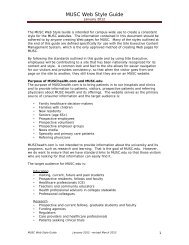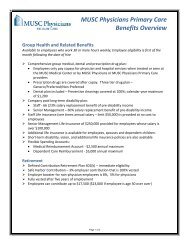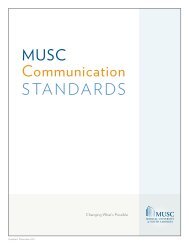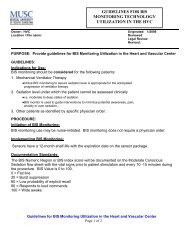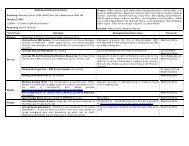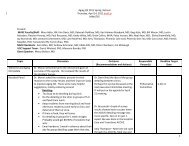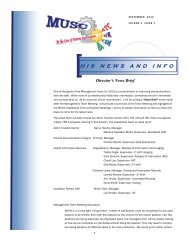"Medication Interventions for Fall Prevention in the Older Adult." J
"Medication Interventions for Fall Prevention in the Older Adult." J
"Medication Interventions for Fall Prevention in the Older Adult." J
Create successful ePaper yourself
Turn your PDF publications into a flip-book with our unique Google optimized e-Paper software.
Reviews <strong>Fall</strong> prevention <strong>in</strong> older adults<strong>Fall</strong>s are def<strong>in</strong>ed as a patient found on <strong>the</strong> floor with noo<strong>the</strong>r explanation <strong>for</strong> position or un<strong>in</strong>tentionally com<strong>in</strong>g to <strong>the</strong>ground or some lower level and o<strong>the</strong>r than as a consequenceof susta<strong>in</strong><strong>in</strong>g a violent blow, loss of consciousness, or suddenonset of paralysis as <strong>in</strong> stroke or epileptic seizure. <strong>Fall</strong>s may benoted by <strong>the</strong> caregiver or from <strong>the</strong> charts and periodic reportsof <strong>the</strong> quality-assurance department of <strong>the</strong> facility. A multifactorialfall risk assessment <strong>in</strong>strument that emphasizes medicationshelps to quantify <strong>the</strong> risk of falls (Figure 1). 1–55Case 1 and self-assessment questionsCase 1A 77-year-old patient and her caregiver <strong>in</strong> your home careand assisted-liv<strong>in</strong>g practice has concerns about fall<strong>in</strong>g. She hasa history of high blood pressure, depression, and osteoarthritis.You use Figure 1 to assess her fall risk (po<strong>in</strong>ts per Figure1). From question<strong>in</strong>g her and her caregiver, she has no historyof falls but gets dizzy when she changes position from ly<strong>in</strong>gdown to sitt<strong>in</strong>g and sitt<strong>in</strong>g to stand<strong>in</strong>g. You take her blood pressureand note that both systolic and diastolic pressure dropafter position change (124–130/70–74 to 105–110/55–60 mmHg). Both of <strong>the</strong>se are evidence <strong>for</strong> orthostasis and dizz<strong>in</strong>ess(2 po<strong>in</strong>ts <strong>for</strong> orthostasis and 1 po<strong>in</strong>t <strong>for</strong> dizz<strong>in</strong>ess on positionchange; 3 po<strong>in</strong>ts total).You notice that she smells of ur<strong>in</strong>ary <strong>in</strong>cont<strong>in</strong>ence and cautionher and her caregiver about adequate fluid <strong>in</strong>take and notgett<strong>in</strong>g up abruptly when she feels dizzy and wait<strong>in</strong>g 10 to 15seconds to get over dizz<strong>in</strong>ess and hold<strong>in</strong>g onto her bed or chairuntil <strong>the</strong> dizz<strong>in</strong>ess subsides. Her <strong>for</strong>earm sk<strong>in</strong> “tents” when <strong>the</strong>sk<strong>in</strong> is held and pulled outward gently between two f<strong>in</strong>gers anddoes not go down <strong>for</strong> 10 to 20 seconds; this poor sk<strong>in</strong> turgorand <strong>the</strong> ur<strong>in</strong>e “sniff” test give a suspicion of ur<strong>in</strong>ary <strong>in</strong>cont<strong>in</strong>ence(2 po<strong>in</strong>ts) that contributes to <strong>the</strong> orthostasis/dizz<strong>in</strong>essproblem.If you have lab data available and a recent ur<strong>in</strong>alysis hasbeen done, check<strong>in</strong>g <strong>the</strong> ur<strong>in</strong>e specific gravity (N = 1.005–1.030) and see<strong>in</strong>g recent values greater than 1.015 may <strong>in</strong>dicaterelative dehydration and personal as well as caregiverfluid deprivation. Simply put, both <strong>the</strong> patient and her caregiverslearn that fluid taken <strong>in</strong> orally may leak without warn<strong>in</strong>gbecause of <strong>in</strong>cont<strong>in</strong>ence. The patient may be concerned thatshe cannot af<strong>for</strong>d <strong>the</strong> <strong>in</strong>cont<strong>in</strong>ence underpads that prevent embarrass<strong>in</strong>gleakage <strong>in</strong>to <strong>the</strong> outer garments. She uses a walkerto access <strong>the</strong> toilet, which is <strong>in</strong> <strong>the</strong> next room. You recommenda closer placement of <strong>the</strong> bed to <strong>the</strong> toilet and a bedside toiletor bedpan <strong>for</strong> use when <strong>the</strong> patient feels she cannot make it to<strong>the</strong> toilet “<strong>in</strong> time.”The patient is also tak<strong>in</strong>g hydrochlorothiazide 25 mg daily(1 po<strong>in</strong>t) <strong>for</strong> high blood pressure and propoxyphene napsylate/acetam<strong>in</strong>ophen (2 po<strong>in</strong>ts) 10 to 15 doses per week <strong>for</strong> chronicosteoarthritis pa<strong>in</strong>. The diuretic may contribute to <strong>the</strong> patient’s<strong>in</strong>cont<strong>in</strong>ence, orthostasis, and dizz<strong>in</strong>ess, which she says occursseveral times per day. Safer alternatives <strong>for</strong> her high bloodpressure may be an angiotens<strong>in</strong>-convert<strong>in</strong>g enzyme <strong>in</strong>hibitorsuch as lis<strong>in</strong>opril 5 to 20 mg/day or an angiotens<strong>in</strong> receptorblocker such as valsartan 80 to 120 mg/day. Propoxyphene is<strong>in</strong>appropriate <strong>for</strong> pa<strong>in</strong> <strong>in</strong> <strong>the</strong> older adult 30 because of <strong>in</strong>creasedrisk of falls, abnormal heart rhythms, emergency room visits,hospitalizations, and deaths <strong>in</strong> <strong>the</strong> older adult. 17–31 Pla<strong>in</strong> acetam<strong>in</strong>ophen500 mg every 4 hours as needed or on an every-4-hour schedule (e.g., 6:00 am, 10:00 am, 2:00 pm, 6:00 pm,10:00 pm) <strong>for</strong> pa<strong>in</strong> may be a much safer alternative <strong>for</strong> thispatient’s pa<strong>in</strong>. 31 Regular use of acetam<strong>in</strong>ophen 3.0 g/day alsohas been shown to decrease behavioral symptoms by 63% andallow 75% of psychotropic medications to be stopped <strong>in</strong> patientswith cognitive impairment. 32 Fur<strong>the</strong>r anecdotal evidence<strong>for</strong> acetam<strong>in</strong>ophen <strong>in</strong>tervention <strong>in</strong> frequent fallers given psychotropicswith cognitive impairment found that up to three offive (60%) of <strong>the</strong>se patients exhibited less agitation when givenacetam<strong>in</strong>ophen on a regular basis <strong>in</strong> place of <strong>the</strong> stepwise (i.e.,one-drug-at-a-time) and carefully tapered (Table 3) schedule<strong>for</strong> each psychotropic drug(s). 33A check <strong>for</strong> any o<strong>the</strong>r conditions, drugs, and diagnosesreveals that she does have a new prescription <strong>for</strong> zolpidem 5mg as needed <strong>for</strong> sleep (2 po<strong>in</strong>ts) that you dispensed <strong>the</strong> previousweek. You ask about her sleep patterns and learn thatshe takes a 1- to 2-hour nap after each meal and discover thatnei<strong>the</strong>r she nor her caregiver understand that this may be <strong>the</strong>reason she can not sleep well at night. She has only taken twodoses <strong>in</strong> <strong>the</strong> previous week but felt very weak and groggy andunstable on her feet <strong>the</strong> morn<strong>in</strong>g after each dose and almostfell each time she got up dur<strong>in</strong>g <strong>the</strong> night and on awaken<strong>in</strong>g <strong>in</strong><strong>the</strong> morn<strong>in</strong>g. Past research also has shown that medicationsgiven <strong>for</strong> sleep more than once or twice a week may <strong>in</strong>creasefall risk markedly. 13You counsel her and her caregiver on chang<strong>in</strong>g her daytimesleep patterns and stay<strong>in</strong>g out of bed until she is ready to go tosleep at night. A recent study suggests that by avoid<strong>in</strong>g longdaytime naps and giv<strong>in</strong>g hypnotics no sooner than 11:00 pmto midnight, patients may request fewer doses of hypnotics. 34Her depression is not be<strong>in</strong>g currently treated with medications,and she has signs and symptoms consistent with depression.This assessment will not be addressed until all o<strong>the</strong>r medicationchanges are made.Accord<strong>in</strong>g to <strong>the</strong> fall assessment (Figure 1), <strong>the</strong> patient hasa total of 10 po<strong>in</strong>ts, which places her at high risk <strong>for</strong> fall<strong>in</strong>g.Which of <strong>the</strong> follow<strong>in</strong>g changes <strong>in</strong> her medications would yourecommend?Self-assessment questions1. In place of her hydrochlorothiazide, you recommendwhich of <strong>the</strong> follow<strong>in</strong>g?a. An angiotens<strong>in</strong>-convert<strong>in</strong>g enzyme <strong>in</strong>hibitor such aslis<strong>in</strong>oprilb. An angiotens<strong>in</strong> II receptor blocker such as valsartanc. A calcium channel blocker (e.g., diltiazem) or a betablocker (e.g., atenolol)d. Alternative a or b is correct.2. In place of her propoxyphene/acetam<strong>in</strong>ophen, yourecommend which of <strong>the</strong> follow<strong>in</strong>g?e74 • JAPhA • 49:3 • M a y /Ju n 2009www.japha.orgJournal of <strong>the</strong> American Pharmacists Association





